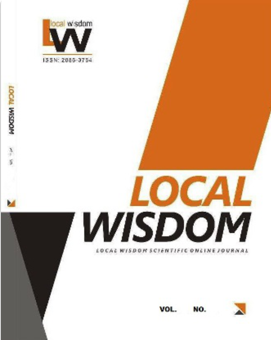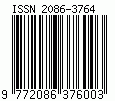The Bamboo Greenhouse Technology For Hydroganic Plants with Independent Photovoltaic Energy in the Food Safety Program
DOI:
https://doi.org/10.26905/lw.v12i1.3676Keywords:
greenhouse, hydroganic, solar energy, food safetyAbstract
The development of the city has made a lot of agricultural land turned into residential land and other urban facilities so that agricultural land becomes increasingly narrow so that it can weaken the food safety program. Another way is needed to utilize narrow land in an effort to develop agricultural products, namely by farming and maintaining fish hydroganic. Hydroganic comes from the words "Hydro" and "Organic" which are defined as organic cultivation systems by combining the hydro system and the organic system. The main source of nutrition from hydroganic is obtained from solid and liquid organic fertilizer and fish pond water that is treated as plant nutrition. The Hydroganic Technology Dissemination Program with independent electricity sources from solar power plants was carried out in Kampung Bunga Grangsil, Jambangan Village, Dampit District, Malang Regency. Communities that are the perpetrators of the activities are the Tourism Awareness Group "Kampoeng Boenga Grangsil" and the "Syakura Arum" Farmer Women's Group. The research method uses a descriptive qualitative method, beginning with the design, the creation of an Independent Energy Hydroganic Greenhouse and the planting of vegetables and fish stocking. Retrieval of data in the form of observations and documentation of photos and videos on activities: a) lectures and discussions; b) practice of making bamboo structures greenhouses; c) the practice of installing hydroganic plants; d) the practice of installing solar power plants; e) Hydroganic vegetable and fish growing practices. Through this program the construction of a tunnel-shaped greenhouse with bamboo structure has been carried out successfully, 2 (two) hydroganic farming facilities complete with fish ponds, 1 (one) solar power generation unit consisting of 4 solar panels each with a capacity of 100 wp with energy storage in the form of a 100 AH 12 V battery and a 1000 WH inverter in sunny conditions producing a minimum of 13.6 Amp, 18.8 V can meet the energy needs to drive the water circulation pump and greenhouse lighting lamps and the surrounding environment. Planting sla and mustard greens as well as spreading catfish and tilapia in mid-August 2019, lettuce vegetables can be harvested at the end of September 2019. The success that can be seen is that when farmers cannot grow vegetables in dry land, the vegetable plants in this hydroganic greenhouse remain fertile and healthy because water circulation occurs continuously. Tunnel-shaped greenhouse with bamboo structure using independent energy for hydropower farming is very practical, efficient and quick to build and can be planted with vegetables and spread fish throughout the year without pause is expected to be a prototype of modern agricultural and fishery facilities without relying on the rainy or dry season in the framework of the program increase national scale food safety.
Â
DOI: https://doi.org/10.26905/lw.v12i1.3676
Downloads
References
Anadia, Nafila, at.al. (2018). “Greenhouse Structure and Functional Analysisâ€. Teknotan Journal Vol. 12 No. 1, April 2018, P - ISSN: 1978-1067; E - ISSN: 2528-6285. Bandung: Faculty of Agricultural Industry Technology, Padjadjaran University.
Handoko. (2014). Bamboo Building Design: Worship Facilities for P4S Tani Mandiri Farmer Community Cibodas Village, Lembang District, Bandung Regency. Community Service Grant. Bandung: LPPM Parahyangan Catholic University.
Hendra, Failasuf Herman. (2015). Designing Hydroponic plant cultivation facilities with a bioclimatic approach. National Seminar on Applied Science and Technology III 2015 ISBN 978-602-98569-1-0 Adhi Tama Institute of Technology Surabaya
Pratiwi, Y. I., Ali, M., Setiawan, M. I., Budiyanto, H., & Sucahyo, B. S. (2017). Urban Agriculture Technology to Support Urban Tourism. ADRI International Journal Of Agriculture, 1(1), 57–60. Retrieved from http://ejournal.p-adri.org/index.php/ijag/article/view/142
Puspitasari, Agnes. (2018). Hydroponic Agricultural Utilization to Overcome the Limitations of Agricultural Land in Urban Areas. National Seminar on Community Service. Open University. September 28, 2018.
Suharyanto, Heri. 2011. Food Security. Journal of Social Humanities, Vol. 4 No.2, November 2011.
Yeniarta. 2017. BBPP Ketindan Develops Organic Vegetables with "Hydroganics" (Organic Hydroponics). Agriculture Articles. No. 15. October 2017. The Center for Agricultural Research (BBPP) Ketindan Malang Regency.
Widayana, Gede. (2012). Utilization of Solar Energy. Journal of Technology and Vocational Education, Ganesha University of Education. Vol.9 no.1 (2012)
Wikantiyoso, R., Cahyaningsih, D. S., Sulaksono, A. G., & Widayati, S. (2019). Sustainable Community Based Ecotourism Development; Grangsil Flower Village Tourism Park, Dampit District, Malang Regency. In SPSD 2019 Conference. SPSD Press.












